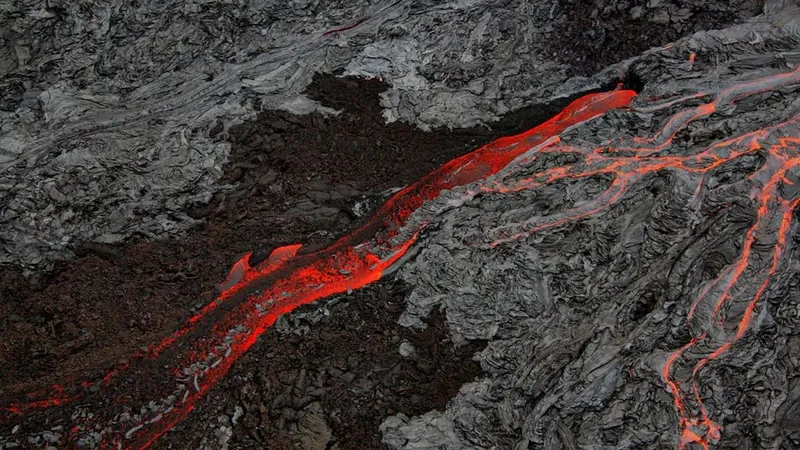
Could "Cryptic Carbon" from Ancient Volcanoes Be the Hidden Culprit Behind Climate Change and Extinctions?
2024-11-29
Author: Yu
Introduction
In a groundbreaking study, researchers have uncovered a fascinating and troubling phenomenon related to massive volcanic eruptions that could provide crucial insights into Earth's climatic past. Their findings suggest that carbon dioxide (CO2), locked away in underground magmas, may continue to seep into the atmosphere long after eruptions have come to a halt. This "cryptic carbon" could explain prolonged warming periods, sluggish climate recovery, and even mass extinctions that have devastated ecosystems throughout history.
Impact of Massive Volcanic Eruptions
Massive volcanic eruptions, such as those from large igneous provinces, have dramatically altered the Earth’s climate at different points in time. Isabel Fendley, a geologist at Pennsylvania State University, emphasizes that the release of CO2 isn't just linked to immediate eruptions but may be occurring over millions of years. This revelation challenges current understandings of volcanic gas emissions and suggests that researchers might be missing a critical piece in the climate-emission puzzle.
Research Focus and Findings
The researchers focused on vast areas of land underlain by magma, known as large igneous provinces. The most recent of these, the Columbia River Basalt Group, erupted about 16 million years ago, and while there are no active large igneous provinces today, the scale of eruptions from such regions can be mind-boggling. Ben Black, the lead author of the study and a volcanologist at Rutgers University, underscores the sheer magnitude of these events, which are capable of mobilizing enough magma to bury the continental United States under half a kilometer of volcanic rocks.
Historical Context
Historically, such extensive volcanism has coincided with severe climate disruptions. For instance, the Siberian Traps eruptions around 252 million years ago are linked to the end-Permian mass extinction event, which saw a staggering loss of biodiversity. Strikingly, temperatures and CO2 levels remained elevated for approximately 5 million years after these catastrophic eruptions ceased. Scientists had attributed these prolonged warming periods to weakened natural processes that help regulate the planet's temperature, but the latest study offers an alternative explanation: lingering CO2 leakage.
Model Simulation and Results
Published in the esteemed journal Nature Geoscience, the research team utilized numerical models to simulate how carbon and nutrient flows affect climatic conditions. Their simulation revealed that CO2 emissions from surface eruptions alone cannot sufficiently account for the extended periods of warmth observed after these volcanic activities. Instead, they propose that carbon could continue to escape from subsurface magmas long after surface eruptions have ended.
Magma Movement and CO2 Release
To validate their theory, the researchers explored the movement of magma through Earth's crust over time, noting how the crust's deformation impacts carbon release. Initially, magma pressure builds up until eruptions occur, allowing gas to escape. However, as the surrounding rock becomes more pliable with heat, it becomes increasingly difficult for new eruptions to occur. Even so, the dissolved CO2 can still escape, much like gas bubbles in a shaken soda bottle once the cap is removed.
Long-lasting Effects of CO2 Release
Remarkably, the study suggests that this CO2 release could persist for millions of years following the last magma eruption. Such cryptic carbon leakage could elucidate the lengthy warming trends accompanying the cessation of large igneous province eruptions and has significant implications for understanding biological recovery during cataclysmic events such as the end-Permian mass extinction.
Recovery Dynamics
Black notes the importance of this research in grasping the recovery dynamics after mass extinctions and climate upheavals. He emphasizes the need for further exploration into how solid Earth processes influence the emergence of new life following such devastations.
Implications for Current Climate Issues
The implications of this research extend to contemporary issues as well. With human-induced carbon emissions skyrocketing, large igneous provinces offer valuable analogs for examining natural carbon emission patterns, albeit at slower rates. Tamsin Mather, a volcanologist at the University of Oxford and co-author of the study, believes understanding past recovery mechanisms could shed light on the potential impacts of current anthropogenic emissions.
Conclusion
In summary, the mystery of cryptic carbon could not only reshape our understanding of Earth's climatic history but also enhance our awareness of how the planet and its ecosystems might cope amid today's climate crisis. What else could this hidden gas reveal about our world? Only time and further research will tell!



 Brasil (PT)
Brasil (PT)
 Canada (EN)
Canada (EN)
 Chile (ES)
Chile (ES)
 España (ES)
España (ES)
 France (FR)
France (FR)
 Hong Kong (EN)
Hong Kong (EN)
 Italia (IT)
Italia (IT)
 日本 (JA)
日本 (JA)
 Magyarország (HU)
Magyarország (HU)
 Norge (NO)
Norge (NO)
 Polska (PL)
Polska (PL)
 Schweiz (DE)
Schweiz (DE)
 Singapore (EN)
Singapore (EN)
 Sverige (SV)
Sverige (SV)
 Suomi (FI)
Suomi (FI)
 Türkiye (TR)
Türkiye (TR)